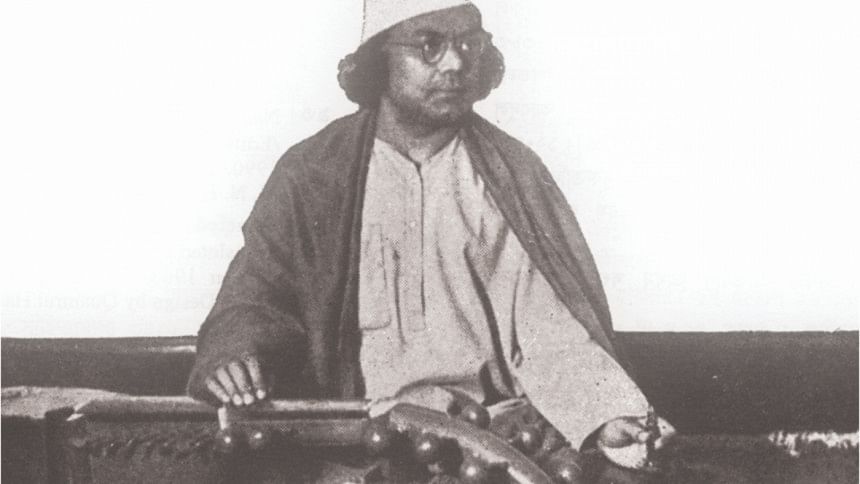Kazi Nazrul Islam the versatile music composer

Kazi Nazrul Islam's genius cuts across a wide swathe. But his particular forte lies in his music. As he once prophesised, people would remember him for a long time for his songs if not for his other works. He was a musician with proficiency in almost all the areas of the music patterns of this subcontinent.
Nazrul's songs are basically Kavya Sangeet, poems accompanied with tune and music being sung as a song. These are more poems than songs. The term was first used by Subha Guhathakurta for the poetry-songs of Rabindranath Tagore.
Musical genres that Nazrul extensively practiced and applied in his songs are: Kheyal, Thumri, Dhrupad, Dhamar, Dadara, Sadra, Kawali, Shama Sangeet, Tappa, folk and so on. In his 3,200 songs or more, he widely used all those genres.
Nazrul had given us numerous modern songs (AdhunikGaan) with lighter lyrics andup-to-date compositions. Ekhono otheni chand, Nodir srote malar kushum, Polash phooler gelash bhori etc. are cases in point.
When it comes to folk songs by Nazrul, we have Bono bihongo jao re ure, Kandari go koro koro paar, Padmar dheu re, O bhai khati shonar cheye khati amar desher mati, Nodir naam shoianjana nache tirey khon jona etc. Baul is another form of folk song and Nazrul composed his songs in that category too. Ami baul holam dhulir pothey and Kon shudurey chena bashi are among his songs from the Baul genre.
Another area of musical adventure of Nazrul is Kirtan. Kirtan is a devotional genre conceived by Shree Chainanya Dev containing Radha-Krishna dialogues. To name just few of many, we can pick from Baaje monjilo monjiro riniki jhiniki, Ami koloher tore koloho korechi, and Ajo prothomo madhobi futiley kunjey madhobo elona.
A large portion of Nazrul's songs bear the characteristics of the ghazal. Nazrul'sghazals were what attracted the listeners of his age the most. Few of his ghazals are Porodeshi bodhua ele ki eto diney, Ashile bhanga ghore ke mor ranga otithi, Shiuli phuler mala doley, among others.
Islamic compositions by Nazrul are his songs known as qawaali. This is a form of Sufi devotional music genre characterised by rhythmic patterns expressed by clapping.
Thanks to his early career in the defence, many of Nazrul's songs reflected the faster tempo resembling the defence music pattern. Chal chal chal, Karar oi louho kapat and Durgam giri kantar moru are compositions of that kind.
A less known aspect of Kazi Nazrul Islam was as a successful playback director. In the year 1934, he jointly directed the film Dhrubo with Satyendra Nath Dey. In the same film he acted, composed the music as a music director, and sang the songs too. He had to face criticism from Visva Bharati University for directing music in the film Gora, based on Tagore's novel. Visva Bharati University refused to give the clearance certificate for the film showing concern about its music. When Nazrul approached Rabindranath and explained his standpoint, Rabindranath gave the clearance famously saying to Nazrul, “Since you directed the music, I am giving my clearance.”
Nazrul created his own style and a new trend as a music director in films. Until 1945, nearly 50 Nazrul songs were used in different films. In the film Shoilojananda, Nazrul wrote and composed a new genre of songs, which was later labelled as 'Nazrul Jhumur' by the Nazrul enthusiasts. In those songs, he successfully blended Santali rhythm and jhumurtaals. In 1939, Nazrul composed and directed songs for the film Sapurey. The songs Akashey helan diye and Bou kosne katha were recorded for movies in the voice of the eminent singer Kanon Devi; they were greatly popular at that time and still are. Kazi Nazrul Islam was also the lyricist of the playbacks of Nandini (1940) and Dilkush (1943). He was the music composer of the movies such as Chourangi (1942), GraherPher (1937) and Bidyapati (1937). The movie Bidyapati was based on Nazrul's play with the same title. Nazrul composed and directed the playback songs for the Hindi version of this movie too. Nazrul's popularity as a music director of films earned him the title of “Sur Bhandar” – a feat that no other music director in the subcontinent has been able to rival.

 For all latest news, follow The Daily Star's Google News channel.
For all latest news, follow The Daily Star's Google News channel. 



Comments